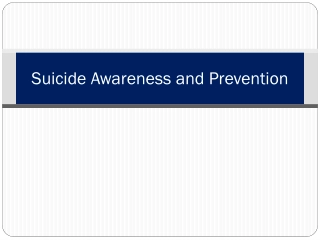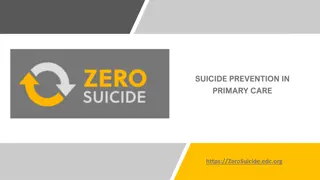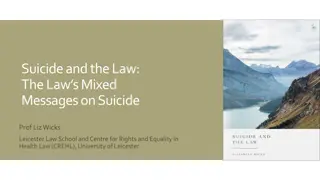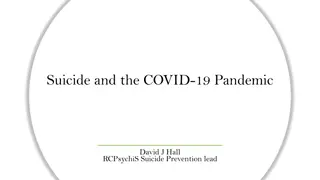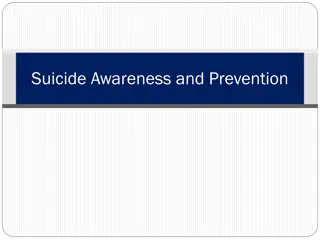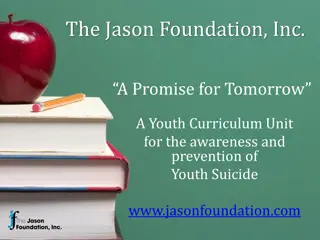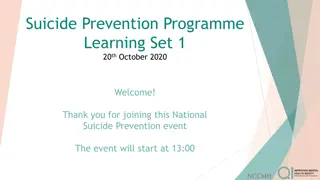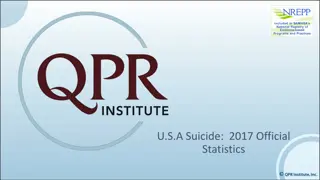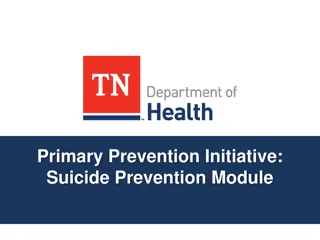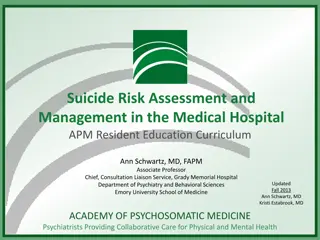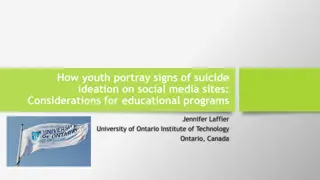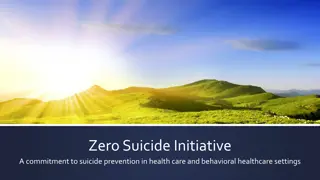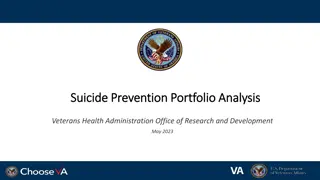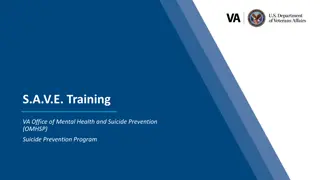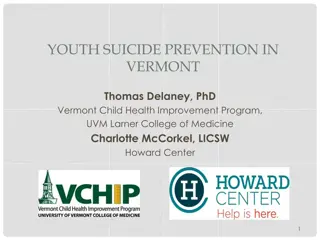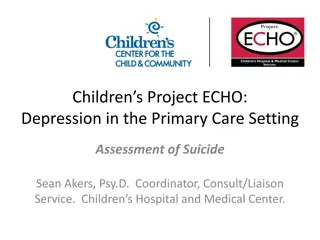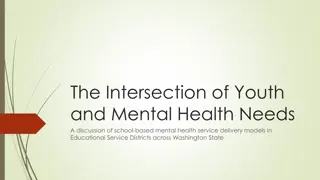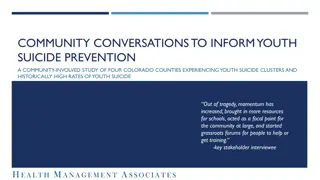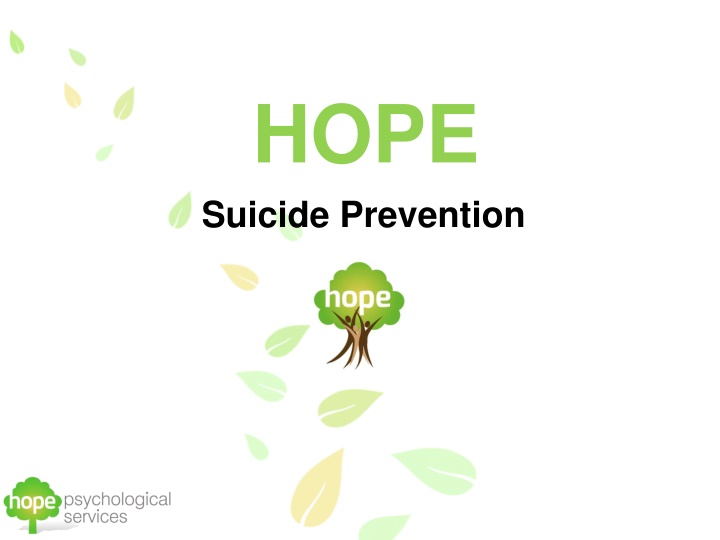
Suicide Prevention Strategies and Risk Factors
Explore essential information on suicide prevention, risk factors, and awareness strategies. Learn how to assess risk and prevent suicides effectively. Gain insights into the National Suicide Prevention Strategy for England and the alarming statistics surrounding suicide rates across different demographics.
Download Presentation

Please find below an Image/Link to download the presentation.
The content on the website is provided AS IS for your information and personal use only. It may not be sold, licensed, or shared on other websites without obtaining consent from the author. If you encounter any issues during the download, it is possible that the publisher has removed the file from their server.
You are allowed to download the files provided on this website for personal or commercial use, subject to the condition that they are used lawfully. All files are the property of their respective owners.
The content on the website is provided AS IS for your information and personal use only. It may not be sold, licensed, or shared on other websites without obtaining consent from the author.
E N D
Presentation Transcript
HOPE Suicide Prevention
Housekeeping Zoom etiquette Text 07816 816152 if cut off Agenda Group agreement Write down a thought and a feeling about suicide Write down a hope or concern about this training session. Choose to share a thought OR a feeling with the group that is immediate and connected to the course or course material
Group Agreement Be aware that some people on the call will have had personal experience of feeling suicidal or close friend, family member or student who has taken their life by suicide. Please be sensitive Please be non judgmental and try to be empathic (not: what would I feel in their shoes but rather: What are they feeling? In acknowledgement that we are all different and are affected in different ways Please feel free to discuss feelings about situations rather than identify people you could change a name and or gender if you need to protect confidentiality. Please don t discuss what is raised about individual cases outside the session feel free to discuss the learning. Use I statements I feel this I think that avoid using we as it can sometimes imply a blanket response that no all those implied in the we think or feel
Session Content Background information on Suicide and demographics Risk Factors Approaches to assessing risk Short Q&A time permitting Details of further training opportunities
Suicide Awareness To understand what can be done to prevent suicide we need to understand the variations in risk and the actions we can take to prevent risk National Suicide Prevention Strategy for England, 2002 Suicides are not inevitable, there are many ways in which services communities, individuals and society as a whole can help prevent suicides In England one person dies every two hours as a result of suicide. Suicide is often the end point of a complex history of risk factors and distressing events; the prevention of suicide has to address this complexity National Suicide Prevention Strategy for England, 2012 National Suicide Prevention Strategy for England, 2012
Fact Suicide is one of the major causes of death accounting for 1% of all deaths annually Suicide is the single most frequent cause of death recorded in males under the age of 35 Suicide is more common in those under threat of redundancy or who have recently lost their job Suicide is high in males in the 35-49 age group- this has changed since the previous review (it used to be young males more at risk) Especially those with drug or alcohol problems or in trouble with the police Older men (over 75) also have higher rates of death by suicide, which may reflect the impact of depression, social isolation, bereavement or physical illness.
Fact Suicide is more common in those who are socially isolated or who have no particular aims in life. It is also more common in those who have recently separated bereaved 95% of suicide occur in people suffering from a mental or emotional disorder most typically depression Alcohol and drugs are implicated in both deliberate self-harm and death by suicide with at least half of all suicides being associated with drug or alcohol problems Imprisonment or contact with CJS or YJS are associated with higher suicide rates Suicide is higher amongst gay, lesbian and transgender groups Minority groups are also over represented in suicide figures
Suicides One million suicides worldwide per year (equal to population of Birmingham). Death by suicide every 40 seconds in the world (45 during an Eastenders episode). Increase of suicides in the world in last 45 years of 60%. Estimated 20 failed suicide attempts to every successful suicide attempt. (900 during an Eastenders episode).
Methods of suicide by Gender Hanging, strangling, suffocation Drug related poisoning Other poisoning (motor gas) Jumping/falling Other Males (3,172) Females (1,126) 46% 19% 8% 3% 24% 26% 44% 3% 5% 23%
Some unhelpful thoughts . THERE IS NO WAY OF KNOWING WHO IS GOING TO COMMIT SUICIDE ASKING PEOPLE ABOUT SUICIDE WILL INCREASE THE RISK PEOPLE WHO ARE SERIOUS ABOUT COMPLETING SUICIDE DO NOT TELL ANYONE ELSE
PEOPLE WHO SELF HARM ARE JUST ATTENTION SEEKING AND ARE NOT AT RISK OF SUICIDE SINCE UNEMPLOYMENT AND POVERTY ARE THE MAIN CAUSES OF SUICIDE THERE IS LITTLE THAT I CAN DO TO PREVENT IT
Helpful quote Suicide is best understood not so much as a movement towards death but as a movement away from something and that something is always the same: intolerable emotion, unendurable pain or unacceptable anguish. Reduce the level of suffering and the individual will choose to live. Edwin Shineidman
Theories Schneidman (1993) identifies; pain (psychache) Press (stress) Perturbation (agitation / needing to act out ) Baumieister (1990) escape from: situation (relational ) sense of self (internal) Aaron Beck (1996) Hopeless thoughts Jobes (2016) Collabourative Assessment and Management of suicidality leaning on above theories plus other factors such as collaboration and honesty from practitioners and treating suicidality directly
Suicide Assessment and Prevention modules Safety Management Assessment Hope Enhancer Relapse Prevention Problem Solving
Assessment Module 1
Think. If I felt suicidal what would I want/need from the person I was speaking to? Can you imagine what it would be like to have no hope for the future and no ideas how you can get through your current situation.
Interview Skills Confidentiality Unless harm to self or others is indicated Offer empathic support Allowing emotional release whilst holding the interview Improving Hopefulness - hope and confidence Bolster self-esteem Establish good rapport Demonstrate acceptance Acknowledge current problem
Interview Skills Questioning style Specific and direct where necessary Clarify ambiguities Reflective questions Pick up verbal cues and non-verbal cues Summarise
Exploring Suicidal Risk 1. Hopelessness It is the bestsingle psychological predictor of suicide risk 2. 3. 4. Generally what are the high risk categories 5. Factors which make suicide more or less likely Anything specific to the individual to look out for Background knowledge Current problems and past attempts Degree and seriousness of intent Specific plans for suicide Risk Factors
1. Hopelessness Explore view of the future Is there anything that you are looking forward to? Can you see a way through this? Can you see an end to your problems?
Helper Don t get sucked into hopelessness You can't please all the people all the time Seek help and supervision Don t be overly responsible remember this is not your problem and making it your problem wont help .
2. Background knowledge Current problems Especially last 48 hours leading up to an attempt Past triggers / problems Past self-harm / suicide attempts Degree and seriousness Past coping skills What has worked in the past
3. Plans for Suicide Have you got a plan? How detailed is the plan? When, where, how and by what means? What measures have been utilised to prevent detection? What has stopped you carrying that out so far?
4. Risk Factors Gender, ethnicity and sexuality Social isolation: No friends No meaningful emotional support from family Role Change: No meaningful role in life: Unemployment Retirement No family role Recent separation / divorce / bereavement
Poor physical health: Long-term, chronic illness Especially if not treatment responsive History of violence towards others Homicidal thoughts: murder-suicides are not rare History of violent self-harm e.g. attempted hanging Alcohol or drug problems Current mental illness
5. Factors which make Suicide more or less likely Risk is increased if there is An immediate intention to carry out suicide A choice of violent method Current symptoms of mental illness Recurrent alcohol or drug problem/intoxication A past high risk attempt Self loathing
The likelihood of further bad news - the last straw A self-imposed deadline has passed Recent escalation of: Suicidal Behaviour Maladaptive Behaviour Help Seeking Behaviour Self Harming Behaviour HIGH suicide risk is indicated if there is increased frequency and/or seriousness of attempts
Risk is decreased if a person is Looking forward to future events Suggesting that suicide is not intended if a particular event occurs - lowers immediate risk only Afraid of: Death Physical or mental damage inflicted if attempt fails Impact on family or friends No one to care for children and/or significant others No access to the means of suicide
Suicidal Intent How to ask the death question What are your experiences?
Indirect Do you feel like harming yourself? Do you feel like getting away from it all? So that I understand you clearly, do you mean that you want to kill yourself? Normalising Sometimes when people are feeling distressed they think of suicide, is this something you ve been thinking of? Direct Have you been thinking of killing yourself? Do you want to be dead and away from it all?
Summary You should ask about: Suicidal intent - thoughts of death Degree and seriousness - plan, means & measures to prevent detection Background - current problems Hopelessness, worthlessness & feelings of being trapped Symptoms of mental illness and/or signs of psychological distress, alcohol & drug use Past suicide attempt or self-harm Preparation for death final acts, suicide note, Will Coping mechanisms - what stopped them from carrying it out so far?
Some Symptoms of Clinical Depression Loss of interest or pleasure for at least 2 weeks - plus at least 3 of the following: Altered sleep pattern Changes in appetite Little energy or motivation Restlessness, agitation or feeling slowed-up Guilt or worthlessness Thoughts of death
Depressed people can have: Anxiety symptoms Worry, restlessness, tension, impending doom, increased respirations, palpitations Delusions Fixed false beliefs not amenable to reason Hallucinations False sensory experiences A history of mania Excessive over activity
Ensuring Safety Ensure safety by: Identifying means of lethality Check for other means using the A-Test What is Acceptable to the person What is Available to the person Removing or restricting the means of lethality Safely and with the least distress Utilising safety protocols for removal or restriction of dangerous weapons
Appropriate Support Identify who is best able to provide support Professionals Family & Friends Community network Is the person comfortable with the kind of support being suggested? Ensure support is available and accessible During the night At Weekends On Bank Holidays
Family, Friends & Community Support Can offer better support than professionals with the following considerations: They must be: Agreeable to become involved in the support network Informed of the suicidal risk and offered appropriate support Given guidance on what to do if the situation worsens Careful consideration before engaging teenagers and immature people Parents of teenagers & children may become too overprotective / judgemental
Thank You Further Training: Suicide & Self Harm 2 days Autumn 2021 Introduction to Counselling April 24th 2021 (Saturday mornings) Contact Nathan@psychological-services.org.uk to be added to mailing list https://www.hopetraining.org

